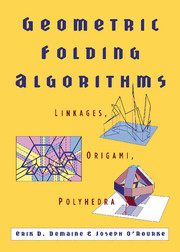Book contents
- Frontmatter
- Contents
- Preface
- 0 Introduction
- Part I Linkages
- Part II Paper
- 10 Introduction
- 11 Foundations
- 12 Simple Crease Patterns
- 13 General Crease Patterns
- 14 Map Folding
- 15 Silhouettes and Gift Wrapping
- 16 The Tree Method
- 17 One Complete Straight Cut
- 18 Flattening Polyhedra
- 19 Geometric Constructibility
- 20 Rigid Origami and Curved Creases
- Part III Polyhedra
- Bibliography
- Index
16 - The Tree Method
Published online by Cambridge University Press: 07 September 2010
- Frontmatter
- Contents
- Preface
- 0 Introduction
- Part I Linkages
- Part II Paper
- 10 Introduction
- 11 Foundations
- 12 Simple Crease Patterns
- 13 General Crease Patterns
- 14 Map Folding
- 15 Silhouettes and Gift Wrapping
- 16 The Tree Method
- 17 One Complete Straight Cut
- 18 Flattening Polyhedra
- 19 Geometric Constructibility
- 20 Rigid Origami and Curved Creases
- Part III Polyhedra
- Bibliography
- Index
Summary
The tree method of origami design is a general approach for “true” origami design (in contrast to the other topics that we discuss, which involve less usual forms of origami). In short, the tree method enables design of efficient and practical origami within a particular class of 3D shapes. Some components of this method, such as special cases of the constituent molecules and the idea of disk packing, as well as other methods for origami design, have been explored in the Japanese technical origami community, in particular by Jun Maekawa, Fumiaki Kawahata, and Toshiyuki Meguro. This work has led to several successful designs, but a full survey is beyond our scope (see Lang 1998, 2003). It suffices to say that the explosion in origami design over the last 20 years, during which the majority of origami models have been designed, may largely be due to an understanding of these general techniques.
Here we concentrate on Robert Lang's work (Lang 1994a, b, 1996, 1998, 2003), which is the most extensive. Over the past decade, starting around 1993, Lang developed the tree method to the point where an algorithm and computer program have been explicitly defined and implemented: TreeMaker is freely available and runs on most platforms. Lang himself has used it to create impressively intricate origami designs that would be out of reach without his algorithm. Figure 16.1 shows one such example.
Information
- Type
- Chapter
- Information
- Geometric Folding AlgorithmsLinkages, Origami, Polyhedra, pp. 240 - 253Publisher: Cambridge University PressPrint publication year: 2007
